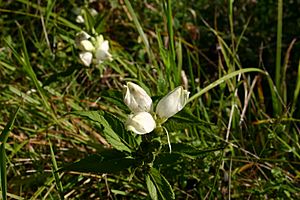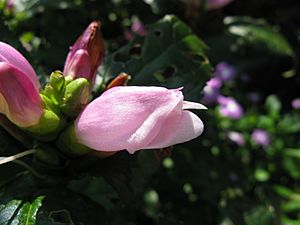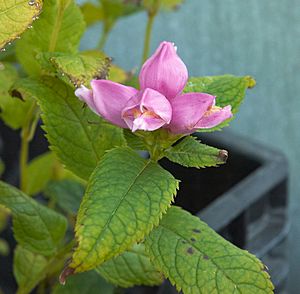Chelone (plant) facts for kids
Quick facts for kids Chelone (plant) |
|
|---|---|
 |
|
| Chelone glabra | |
| Scientific classification |
|
| Kingdom: | Plantae |
| Clade: | Tracheophytes |
| Clade: | Angiosperms |
| Clade: | Eudicots |
| Clade: | Asterids |
| Order: | Lamiales |
| Family: | Plantaginaceae |
| Tribe: | Cheloneae |
| Genus: | Chelone L. |
| Species | |
|
|
Chelone (say "KEE-lone") is a group of four kinds of plants. They are also known as turtlehead plants. This is because their flowers look a lot like the head of a turtle! These plants grow year after year, so they are called perennials. You can find them in eastern North America. Their flowers come in many colors, like white, red, purple, or pink.
Contents
Different Kinds of Turtlehead Plants
There are four main types of Chelone plants. Each one grows in slightly different areas:
Cuthbert's Turtlehead (Chelone cuthbertii)
This plant grows in two main places. You can find it in the Blue Ridge Mountains of North Carolina. It also grows in the flat coastal areas of Virginia.
White Turtlehead (Chelone glabra)
This is the most common type of turtlehead plant. It grows across a very wide area. You can find it from Georgia all the way up to Newfoundland. It also stretches from Mississippi to Manitoba in Canada.
Lyon's Turtlehead (Chelone lyonii)
This kind of turtlehead plant likes the mountains. It is found in the Blue Ridge Mountains. You can see it in Tennessee, North Carolina, and South Carolina.
Pink Turtlehead (Chelone obliqua)
The Pink Turtlehead grows in a few different places. Some grow in the Blue Ridge Mountains. Others are found from Tennessee to Arkansas and Michigan. You can also spot them along the Atlantic coast from South Carolina to Maryland.
Scientists believe that these four types of Chelone plants are quite new. They think they have only recently become separate kinds of plants.
See also
 In Spanish: Chelone para niños
In Spanish: Chelone para niños



